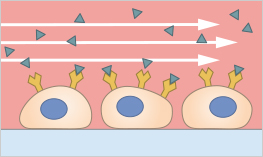Principle
In vivo, endothelial cells develop and differentiate under shear stress conditions. When starting cell-based assays with endothelial cells, you should consider the possible influence of this mechanical force on cell morphology and physiology. To bring the cells to a more physiological, in vivo-like state, they are cultured under flow for hours up to several weeks, generating more relevant results. In other words, flow conditioning is crucial for any kind of investigations using cells that are physiologically underlying flow conditions.
Application Examples
- Investigating the influence of shear stress on endothelial cell physiology with various experimental readouts, such as immunofluorescence, western blot, qPCR, and FACS
- Preparing the cell layer for subsequent functional assays, such as rolling and adhesion or transmigration assays

| Flow characteristics | Continuous laminar flow, Non-uniform flow, Oscillatory flow (needed for disturbed flow simulation), Pulsatile flow |
| Experiment duration | Hours, up to several weeks |
| Recommended pumps | ibidi Pump System |
| Recommended μ-Slides | μ-Slide I Luer Family, μ-Slide VI 0.4, μ-Slide y-shaped |
Principle
In a rolling and adhesion assay, leukocytes and/or platelets are perfused over a surface with a protein coating or a cell layer. Their adhesion to and their interaction with the surface can be analyzed under various conditions (e.g., after gene knockdown or drug treatment).
Application Examples
- Investigating the adhesion of platelets and leukocytes on endothelial cells or matrix protein layers
Schulz C, et al. (2009) Novel Methods for Assessment of Platelet and Leukocyte Function Under Flow - Application of Epifluorescence and Two-Photon Microscopy in a Small Volume Flow Chamber Model. Open Biol J 2(1):130–136.
read abstract

| Flow characteristics | Continuous laminar flow |
| Experiment duration | Minutes to hours |
| Recommended pumps | ibidi Pump System, syringe pump, peristaltic pump |
| Recommended μ-Slides | μ-Slide I Luer Family, μ-Slide VI 0.4, μ-Slide y-shaped |
Principle
A channel slide and a pump are used to supply the cells with exactly defined amounts of culture medium and/or any supplement of interest.
Application Examples
- Defined exchange of the cell culture medium
- Live Ca2+-imaging
- Live cell imaging of drug-stimulated adherent cells
- Live cell imaging of cellular stainings

| Flow characteristics | Short periods of laminar flow |
| Duration | Minutes to hours |
| Recommended pumps | Manual liquid delivery, syringe pump, peristaltic pump |
| Recommended μ-Slides | μ-Slide VI 0.4, μ-Slide I Luer Family |
Principle
Cells are cultured in a 3D gel matrix. An interstitial flow is applied directly to the gel to supply the cells with nutrients, O2, and CO2 to maintain optimal conditions.
Application Examples
- 3D culture of single cells, spheroids or organoids in a gel matrix (e.g., with hepatocytes, fibroblasts, muscle cells, kidney cells, and stem cells)

| Flow Characteristics | Very low interstitial flow |
| Duration | Hours, up to several weeks |
| Recommended pumps | ibidi Pump System |
| Recommended μ-Slides | μ-Slide VI 0.4, μ-Slide I Luer Family |
Read on and learn more about the Planning, Setup, and Analysis of a Flow Assay.




